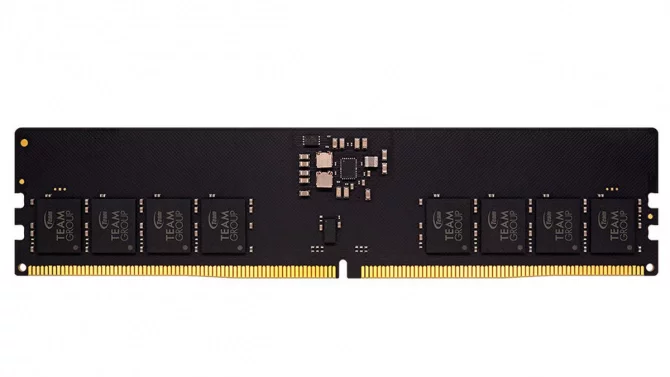You probably know that with DDR5 memories for PCs, the voltage regulators (VRM) for RAM have moved from the motherboard directly to the DIMM modules, in contrast to previous generations. It looks like even more components could be included in the memory, as memory manufacturers have come up with modules that could even have their own clock generator or redriver. Additional clock sources often improved the OC capabilities of processors, and here too it could reach higher frequencies.
Patriot is preparing DDR5 memory with a clock signal booster
Among the various products and prototypes shown at CES 2024, Patriot also had “CKD DDR5” memory modules at its booth, so far in the form of engineering samples. These memories should achieve the highest speeds among DDR5 modules thanks to the integration of the so-called Clock Driver. This is the chip that receives the external clock signal (that is, the “clock” according to which the electronic circuit is controlled, or in this case the DDR5 module) and its job is to boost it.
The electrical signals that make up the memory communication weaken and degrade as they travel further from their source through the PCB boards and slot contacts, which also applies to the reference clock signal that the communication is supposed to follow. Therefore, a chip with a clock booster function is added to these new DDR5 modules. It should not be enormously complex and expensive, production costs could be affected less than the integration of VRM on modules. The Clock Driver should amplify the received clock signal, clean it from interference and smooth out any deviations or inaccuracies, so that the signal is restored and free from the influence of degradation.
It only applies to this clock signal itself, the Clock Driver (CKD) cannot by itself help the data communication on the other wires (of which the 64-bit “wide” RAM module has a lot). However, according to the manufacturers, the strengthening of the clock signal alone should significantly improve the functioning of DDR5 memories. For example, Patriot says that it can easily achieve DDR5-6400 and DDR5-7200 memory speeds using CKD on the module, and that’s with the JEDEC standard. That is, without XMP/EXPO profiles, voltage boosting and other non-standard tricks that overclocked modules use to achieve these speeds.
DDR5 modul Patriot Viper Xtreme 5
Author: Patriot
Even higher targets like DDR5-8400 could be achieved with higher quality CKD chips (redrivers from One Semiconductor are said to be able to do this, for example). Patriot states that such memory should first appear in a version that will run at DDR5-6400 without XMP or EXPO. It will probably be at the cost of worse timing (which improves the overclocking of modules via profiles, while it is very slow in the JEDEC standard). But again, there will be the advantage of the unboosted voltage of 1.1 V.
Even memory overclocking will benefit from CKD on the module. By acting as a clock booster and repeater, it greatly reduces the degree to which you are dependent on the capabilities and “quality” of the memory controller in the CPU when overclocking or generally increasing the effective frequency of DDR5 memories. Even if you have a relatively worse one and the input signal is affected by it, CKD can still regenerate and clean it up to a certain limit. So in general, this technology could bring advancements in memory speeds and greater RAM throughput to desktops and potentially laptops. This can be very important in the future, if the overall performance of processors is to continue to rise while maintaining only dual-channel (meaning 128-bit) memories and the number of cores in the CPU is to grow.
Client Clock Drive u modulů Team Group, CES 2023
Autor: Team Group, via: TechPowerUp
Team Group talked about CKD already a year ago
We first noticed this news with Patriot now at CES 2024, but it looks like the company is not alone. The use of CKD with the same purpose was also announced by the Taiwanese module manufacturer Team Group earlier (even at CES 2023). The Team Group also promises that it will easily achieve high DDR5 frequencies without today’s so common techniques belonging to the area of overclocking.
As far as we know, even this company has not yet released modules equipped with CKD (at Team Group this novelty was supposed to be called Client Clock Drive and was supposed to appear in the memories of the T-Force series), so the commercial deployment of this technology is still a matter of the future – perhaps relatively close ones. The sixteen-core Zen 5 and 6 would probably benefit from significantly better DDR5 bandwidths on the AM5 platform so that their multi-threaded performance is not hampered by memories.
Resources: Tom’s HardwareTeam Group (TechPowerUp)
2024-01-17 06:04:23
#DDR5 #modules #clock #source #path #higher #frequencies #Cnews.cz


